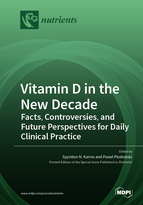Vitamin D in the New Decade: Facts, Controversies, and Future Perspectives for Daily Clinical Practice
A special issue of Nutrients (ISSN 2072-6643). This special issue belongs to the section "Micronutrients and Human Health".
Deadline for manuscript submissions: closed (1 January 2022) | Viewed by 887594
Special Issue Editors
Interests: intermittent fasting; periodic fasting; religious fasting: fasting glucose; obesity; impaired fasting glucose; non-fasting triglycerides; fasting blood glucose; caloric restriction; meal frequency; calorie restriction
Special Issues, Collections and Topics in MDPI journals
Interests: vitamin D and its pleiotropic action; guidelines of vitamin D supplementation; disturbances of calcium-phosphate metabolism; disturbances of bone tissue metabolism; body composition and biological development; basics of statistics; GLP; research methodology
Special Issues, Collections and Topics in MDPI journals
Special Issue Information
Dear colleagues,
Vitamin D has been the focus of tremendous ongoing scientific research during the past two decades. Its primogenetic undisputed role in bone mineralization has been expanded to a strikingly disparate amalgamation of transparent scientific cases and observational studies, randomized controlled trials of doubtful design, and sporadically personal aphorisms and dogma. This phenomenon configures a burgeoning scientific field in which substantial controversy is inevitably reflected in daily clinical practice resulting in a precarious interpretation of not necessarily available results, lifestyle-affected vitamin D supplementation in vitamin D sufficient populations, and ineffective dosing and time regimens.
In this context, somewhere in between the dipole of inordinate enthusiasm and critical opposition, the vast majority of healthcare providers worldwide, involved in some part of the developed vitamin D daily agenda, postulate a sound individualized scientific approach unbiased from quandaries, oriented to improve long term health outcomes and patient quality of life, beyond the platonic caves of available knowledge in the field.
This Special Issue will draw attention to all intriguing and conflicting aspects of vitamin D research, including the following: Vitamin D deficiency and its widespread epidemiology, musculoskeletal, and extra-skeletal effects, critical updates on published vitamin D supplementation prevention RCTs (cancer/ CVD), with a discourse on the future agenda with the main questions: What has changed so far in the field? What are the future research milestones? In collecting the available results reported here, the editors have not endeavored to achieve any sort of completeness, but rather to shed light on the ongoing controversy of the vitamin D “friendly” perspective versus vitamin D skepticism, with a discourse on clinical implications and physicians’ daily decision making, into the beginning of the new decade.
Dr. Spyridon N. Karras
Dr. Pawel Pludowski
Guest Editors
Manuscript Submission Information
Manuscripts should be submitted online at www.mdpi.com by registering and logging in to this website. Once you are registered, click here to go to the submission form. Manuscripts can be submitted until the deadline. All submissions that pass pre-check are peer-reviewed. Accepted papers will be published continuously in the journal (as soon as accepted) and will be listed together on the special issue website. Research articles, review articles as well as short communications are invited. For planned papers, a title and short abstract (about 100 words) can be sent to the Editorial Office for announcement on this website.
Submitted manuscripts should not have been published previously, nor be under consideration for publication elsewhere (except conference proceedings papers). All manuscripts are thoroughly refereed through a single-blind peer-review process. A guide for authors and other relevant information for submission of manuscripts is available on the Instructions for Authors page. Nutrients is an international peer-reviewed open access semimonthly journal published by MDPI.
Please visit the Instructions for Authors page before submitting a manuscript. The Article Processing Charge (APC) for publication in this open access journal is 2900 CHF (Swiss Francs). Submitted papers should be well formatted and use good English. Authors may use MDPI's English editing service prior to publication or during author revisions.
Keywords
- Vitamin D
- Nutrition
- Infections
- Epidemiology
- Cardiovascular disease
- Osteomalacia
- Fasting
- acute infections
- chronic metabolic diseases
- nutrition








